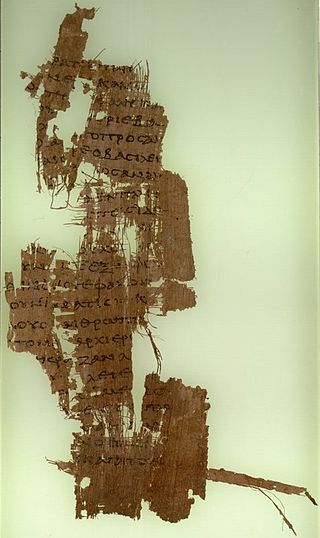Related Research Articles

In the textual criticism of the New Testament, the Byzantine text-type is one of the main text types. It is the form found in the largest number of surviving manuscripts of the Greek New Testament. The New Testament text of the Eastern Orthodox Church, the Patriarchal Text, as well as those utilized in the lectionaries, are based on this text-type. Similarly, the Aramaic Peshitta which often conforms to the Byzantine text is used as the standard version in the Syriac tradition, including the Syriac Orthodox Church and the Chaldean church. Whilst varying in around 1,800 places from printed editions of the Byzantine text-type, it also underlies the Textus Receptus Greek text used for most Reformation-era (Protestant) translations of the New Testament into vernacular languages. Modern translations mainly use eclectic editions that conform more often to the Alexandrian text-type, which is viewed as the most accurate text-type by most scholars, although some modern translations that use the Byzantine text-type have been created.

Textus Receptus refers to the succession of printed editions of the Greek New Testament, starting with Erasmus' Novum Instrumentum omne (1516) and including the editions of Stephanus, Beza, Elzevir, Colinaeus and Scrivener. Additionally, although not being derived from the work of Erasmus, some such as the Trinitarian Bible Society also associate the Complutensian Polyglot with the Textus Receptus tradition.

The Bible has been translated into many languages from the biblical languages of Hebrew, Aramaic, and Greek. As of September 2023 all of the Bible has been translated into 736 languages, the New Testament has been translated into an additional 1,658 languages, and smaller portions of the Bible have been translated into 1,264 other languages according to Wycliffe Global Alliance. Thus, at least some portions of the Bible have been translated into 3,658 languages.

The King James Only movement asserts the belief that the King James Version (KJV) of the Bible is superior to all other translations of the Bible. Adherents of the King James Only movement, mostly members of certain Conservative Anabaptist, traditionalist Anglo-Catholic, Conservative Holiness Methodist and some Baptist churches, believe that the KJV needs no further improvements because it is the greatest English translation of the Bible which was ever published, and they also believe that all other English translations of the Bible which were published after the KJV was published are corrupt.
Partial Bible translations into languages of the English people can be traced back to the late 7th century, including translations into Old and Middle English. More than 100 complete translations into English have been produced. A number of translations have been prepared of parts of the Bible, some deliberately limited to certain books and some projects that have been abandoned before the planned completion.

The New King James Version (NKJV) is a translation of the Bible in contemporary English. Published by Thomas Nelson, the complete NKJV was released in 1982. With regard to its textual basis, the NKJV relies on a modern critical edition for the Old Testament, while opting to use the Textus Receptus for the New Testament.

Frederick Henry Ambrose Scrivener was a New Testament textual critic and a member of the English New Testament Revision Committee which produced the Revised Version of the Bible. He was prebendary of Exeter, and vicar of Hendon.
There have been various debates concerning the proper family of biblical manuscripts and translation techniques that should be used to translate the Bible into other languages. Biblical translation has been employed since the first translations were made from the Hebrew Bible into Greek and Aramaic. Until the Late Middle Ages, the Western Church used the Latin Vulgate almost entirely while the Eastern Church, centered in Constantinople, mostly used the Greek Byzantine text. Beginning in the 14th century, there have been increasing numbers of vernacular translations into various languages. With the development of modern printing techniques, these increased enormously.

John 19 is the nineteenth chapter of the Gospel of John in the New Testament of the Christian Bible. The book containing this chapter is anonymous, but early Christian tradition uniformly affirmed that John composed this Gospel. This chapter records the events on the day of the crucifixion of Jesus, until his burial.

The Svenska Folkbibeln is a contemporary translation of the Bible in Swedish. The New Testament was published in 1996 and the entire Bible in 1998. During the autumn of 2014 a revised edition of the Book of Psalms and the New Testament was published. In 2015 a minor revision of the Old Testament was released together with the 2014 revision of the New Testament, resulting in Svenska Folkbibeln 2015. In this version, the footnotes were also improved and extended. Plans exist for a more thorough revision of the Old Testament, but the 2015 edition will be the one in use for the foreseeable future.

The New Testament in the Original Greek is a Greek-language version of the New Testament published in 1881. It is also known as the Westcott and Hort text, after its editors Brooke Foss Westcott (1825–1901) and Fenton John Anthony Hort (1828–1892). Textual scholars use the abbreviations "WH" or "WHNU". It is a critical text, compiled from some of the oldest New Testament fragments and texts that had been discovered at the time.
Our Authorized Bible Vindicated is a book written by Seventh-day Adventist scholar Benjamin G. Wilkinson advocating the King James Only (KJO) position, published in 1930. It asserted that some of the new versions of the Bible coming out, came from manuscripts with corruptions introduced into the Septuagint with additional texts, which came to be called "Apocrypha", and manuscripts with deletions and changes from corrupted Alexandrian text brought in by manuscript readings in the Greek New Testament adopted by Brooke Foss Westcott and Fenton John Anthony Hort. While King-James-Only advocacy existed prior to the writing of this book, many of the arguments in the book have since become set talking-points of many who support the belief, thanks in large part to Baptist Fundamentalist preacher David Otis Fuller, who adopted them into much of his own material, such as the book, Which Bible?.

Novum Instrumentum Omne, later called Novum Testamentum Omne, was a bilingual Latin-Greek New Testament with substantial scholarly annotations, and the first printed New Testament of the Greek to be published. It was prepared by Desiderius Erasmus (1466–1536), and printed by Johann Froben (1460–1527) of Basel.
Edward Freer Hills (1912–1981) was an American Presbyterian scholar, perhaps the most prominent 20th-century advocate of the Byzantine text-type and Textus Receptus.

Bible translations in Norway date back to the late 13th century. Since the first spread of Christianity in Norway, numerous translations of the Bible have been published. Translations have appeared in several of the official languages that Norway has had throughout its history, including editions in Old Norse, Danish, and both current standard forms Nynorsk and Bokmål.

Textual criticism of the New Testament is the identification of textual variants, or different versions of the New Testament, whose goals include identification of transcription errors, analysis of versions, and attempts to reconstruct the original text. Its main focus is studying the textual variants in the New Testament.

The Modern English Version (MEV) is an English translation of the Bible begun in 2005 and completed in 2014. The work was edited by James F. Linzey, and is an update of the King James Version (KJV), re-translated from the Masoretic Text and the Textus Receptus.

The Byzantine priority theory, also called the Majority Text theory, is a theory within Christian textual criticism held by a minority of textual critics. This view sees the Byzantine text-type as the New Testament's most accurate textual tradition, instead of the Alexandrian text-type or the Western text-type. Known advocates of this view include Maurice Robinson, Zane Hodges and John Burgon. The Majority Text theory is distinguished from the view of those who advocate the Textus Receptus, as although the Byzantine text is very similar to the Textus Receptus as the Textus Receptus mostly relies upon Byzantine manuscripts, it contains a few minority readings which Byzantine priorists reject.

The confession of the Ethiopian eunuch is a variant reading in Acts 8:37, widely seen by Textual Critics to be a later interpolation into the text. It is found in the King James Version due to its existence within the Textus Receptus.
References
- 1 2 "Reformationsbibeln 2016 - Hemsidan". bibel.se. Retrieved 2024-08-19.
- ↑ © Svenska Reformationsbibelsällskapet Andra upplagan, Borås 2016 (2016). Svenska Reformationsbibeln NT KXII.
{{cite book}}: CS1 maint: numeric names: authors list (link) - ↑ "Olika svenska bibelöversättningar - Nya Musik". nyamusik.se. Retrieved 2024-08-19.
- ↑ Andrews, Edward D. (2023-06-15). THE TEXTUS RECEPTUS: The "Received Text" of the New Testament. Christian Publishing House. ISBN 979-8-3984-5852-7.
- ↑ Waltz, Robert B. The Encyclopedia of New Testament Textual Criticism. Robert B. Waltz.
- ↑ Daniel Wallace, "Some Second Thoughts on the Majority Text", Bibliotheca Sacra, July–September, 1989, p. 276.
- ↑ Adolfsson, Jonas (2016-11-15). ""Reformationsbibeln har en tydlig brist"". www.varldenidag.se (in Swedish). Retrieved 2024-08-19.
- ↑ "Gör en kritisk granskning av "Reformationsbibeln"". Dagen (in Swedish). 2004-01-29. Retrieved 2024-08-19.
- ↑ "Borttagna verser får plats i Reformationsbibeln". Dagen (in Swedish). 2003-09-04. Retrieved 2024-08-19.
- ↑ Wasserman, Tommy (2016-12-02). "Reformationsbibeln skapar frågor". www.varldenidag.se (in Swedish). Retrieved 2024-08-19.